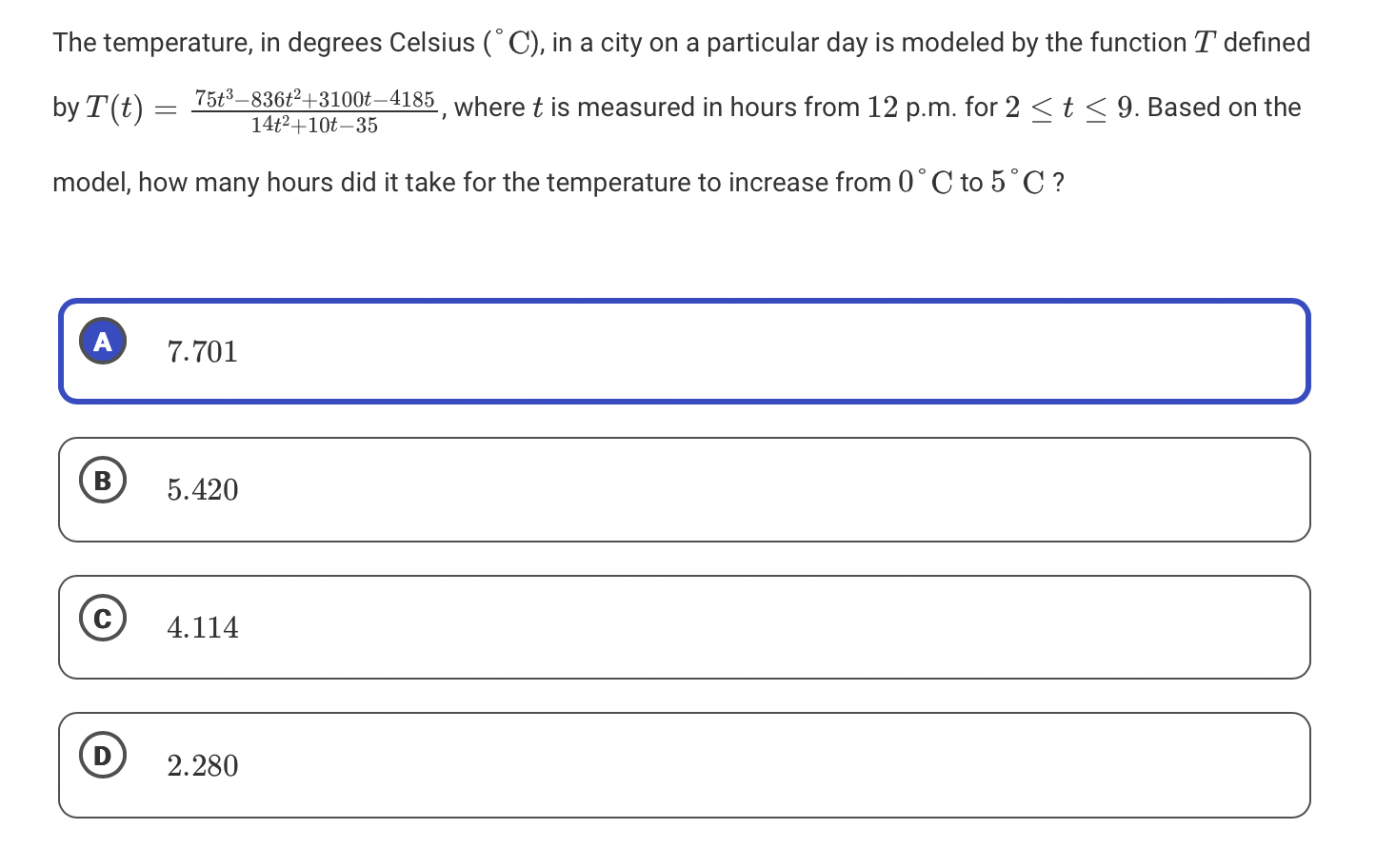The temperature, in degrees Celsius (°C), in a city on a particular day is modeled by the function T defined by T(t) = (75t³ - 836t² + 3100t - 4185) / (14t² + 10t - 35). Based on t... The temperature, in degrees Celsius (°C), in a city on a particular day is modeled by the function T defined by T(t) = (75t³ - 836t² + 3100t - 4185) / (14t² + 10t - 35). Based on the model, how many hours did it take for the temperature to increase from 0 °C to 5 °C?

Understand the Problem
The question is asking how many hours it takes for the temperature to increase from 0 °C to 5 °C based on a given temperature function T(t). The approach involves solving the equation T(t) for the specified temperature values and determining the time interval.
Answer
$5.420$
Answer for screen readers
The time it takes for the temperature to increase from 0 °C to 5 °C is approximately $5.420$ hours.
Steps to Solve
- Set up the temperature function
The temperature function is given by
$$ T(t) = \frac{75t^3 - 836t^2 + 3100t - 4185}{14t^2 + 10t - 35} $$
We need to find the values of $t$ when $T(t) = 0$ °C and $T(t) = 5$ °C.
- Solve for when temperature is 0 °C
Set the temperature function equal to 0:
$$ \frac{75t^3 - 836t^2 + 3100t - 4185}{14t^2 + 10t - 35} = 0 $$
This occurs when the numerator is zero:
$$ 75t^3 - 836t^2 + 3100t - 4185 = 0 $$
- Use numerical methods or a calculator
Finding the roots of the cubic equation can be done using numerical methods such as the Newton-Raphson method or a graphing calculator.
- Solve for when temperature is 5 °C
Next, set the function equal to 5:
$$ \frac{75t^3 - 836t^2 + 3100t - 4185}{14t^2 + 10t - 35} = 5 $$
This simplifies to the equation:
$$ 75t^3 - 836t^2 + 3100t - 4185 - 5(14t^2 + 10t - 35) = 0 $$
Simplifying gives:
$$ 75t^3 - 836t^2 + 3100t - 4185 - 70t^2 - 50t + 175 = 0 $$
Combine like terms:
$$ 75t^3 - 906t^2 + 3050t - 4010 = 0 $$
- Use numerical methods or a calculator
Again, use numerical methods to find the roots of this new cubic equation.
- Calculate the time difference
Once you have the values of $t$ at which the temperature reaches 0 °C and 5 °C, subtract the two values to find the time taken for the temperature to increase.
The time it takes for the temperature to increase from 0 °C to 5 °C is approximately $5.420$ hours.
More Information
The function provided models temperature changes over time, and solving these equations helps us understand how temperature varies throughout the day. Numerical methods are often used for such cubic equations when they cannot be solved easily by hand.
Tips
- Not simplifying the equations correctly when setting them equal to 0.
- Incorrectly using the cubic formula can lead to errors in finding roots.
- Forgetting to check the interval $2 \leq t \leq 9$ to ensure calculated roots are valid.
AI-generated content may contain errors. Please verify critical information